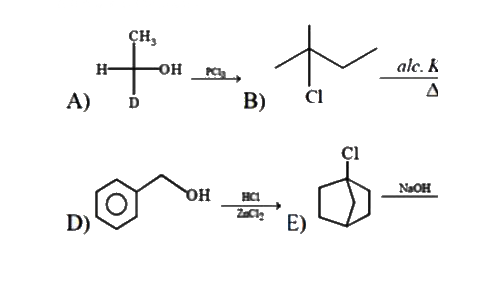What are nucleophilic substitution reactions ? Give an example.
Step-by-Step Solution
1. Definition of Nucleophilic Substitution Reactions:
- Nucleophilic substitution reactions are a class of organic reactions in which one nucleophile replaces another nucleophile. In simpler terms, it involves the substitution of one atom or group of atoms in a molecule by another nucleophile.
2. Understanding Nucleophiles:
- A nucleophile is a species that donates an electron pair to form a chemical bond. In nucleophilic substitution reactions, nucleophiles attack electrophilic centers (usually carbon atoms bonded to a leaving group).
3. Comparison with Displacement Reactions:
- These reactions can be compared to displacement reactions where a more reactive element displaces a less reactive element. In nucleophilic substitution, a nucleophile replaces another nucleophile.
4. Example of Nucleophilic Substitution Reaction:
- Consider the reaction of an alkyl halide, such as bromomethane (CH3Br), with a nucleophile like hydroxide ion (OH-).
- The reaction can be represented as:
CH3Br+OH−→CH3OH+Br−
- In this reaction, the hydroxide ion (OH-) attacks the carbon atom bonded to the bromine (Br), resulting in the substitution of bromine with hydroxide. Here, bromine acts as the leaving group, and the resulting product is methanol (CH3OH).
5. Identification of Key Terms:
- Substrate: The molecule undergoing substitution (in this case, CH3Br).
- Leaving Group: The atom or group that is replaced (in this case, Br-).
- Product: The new molecule formed after substitution (in this case, CH3OH).
Summary
Nucleophilic substitution reactions involve the replacement of one nucleophile by another, typically resulting in the formation of a new compound and the release of a leaving group.
---
- Nucleophilic substitution reactions are a class of organic reactions in which one nucleophile replaces another nucleophile. In simpler terms, it involves the substitution of one atom or group of atoms in a molecule by another nucleophile.
- A nucleophile is a species that donates an electron pair to form a chemical bond. In nucleophilic substitution reactions, nucleophiles attack electrophilic centers (usually carbon atoms bonded to a leaving group).
- These reactions can be compared to displacement reactions where a more reactive element displaces a less reactive element. In nucleophilic substitution, a nucleophile replaces another nucleophile.
- Consider the reaction of an alkyl halide, such as bromomethane (CH3Br), with a nucleophile like hydroxide ion (OH-).
- The reaction can be represented as:
CH3Br+OH−→CH3OH+Br−
- In this reaction, the hydroxide ion (OH-) attacks the carbon atom bonded to the bromine (Br), resulting in the substitution of bromine with hydroxide. Here, bromine acts as the leaving group, and the resulting product is methanol (CH3OH).
- Substrate: The molecule undergoing substitution (in this case, CH3Br).
- Leaving Group: The atom or group that is replaced (in this case, Br-).
- Product: The new molecule formed after substitution (in this case, CH3OH).
Nucleophilic substitution reactions involve the replacement of one nucleophile by another, typically resulting in the formation of a new compound and the release of a leaving group.
Topper's Solved these Questions
- ORGANIC CHEMISTRY : SOME BASIC PRINCIPLES AND TECHNIQUES BOOK - ICSECHAPTER - ORGANIC CHEMISTRY : SOME BASIC PRINCIPLES AND TECHNIQUES EXERCISE - ESSAY ( LONG ANSWER ) TYPE QUESTIONS
42 Videos
- ORGANIC CHEMISTRY : SOME BASIC PRINCIPLES AND TECHNIQUES BOOK - ICSECHAPTER - ORGANIC CHEMISTRY : SOME BASIC PRINCIPLES AND TECHNIQUES EXERCISE - OBJECTIVE ( MULTIPLE CHOICE ) TYPE QUESTIONS
142 Videos
- ORGANIC CHEMISTRY : SOME BASIC PRINCIPLES AND TECHNIQUES BOOK - ICSECHAPTER - ORGANIC CHEMISTRY : SOME BASIC PRINCIPLES AND TECHNIQUES EXERCISE - VERY SHORT ANSWER TYPE QUESTIONS
87 Videos
- HYDROGENBOOK - ICSECHAPTER - HYDROGENEXERCISE - NCERT TEXT-BOOK EXERCISE (With Hints and Solutions)
53 Videos
- REDOX REACTIONS (OXIDATION AND REDUCTION)BOOK - ICSECHAPTER - REDOX REACTIONS (OXIDATION AND REDUCTION)EXERCISE - NCERT TEXT-BOOK. EXERCISES ((With Hints and Solutions)
69 Videos
Similar Questions
Knowledge Check
Which of the following reactant will not favour nucleophilic substitution reaction ?
A BPh-BrCCH3CH3∣C∣CH3−CH2−BrDAll the above
BPh-BrCCH3CH3∣C∣CH3−CH2−BrDAll the aboveWhich one of the following is most reactive towards nucleophilic substitution reaction ?
ACH2=CH−ClBC6H5ClCCH3CH=CHClDClCH2−CH=CH2Which ofthe following is most reactive towards nucleophilic substitution reaction ?
ACH2=CH−ClBC6H5ClCCH3CH=CHClDClCH2−CH=CH2
Identify number of nucleophilic substitution reactions in the given reactions?

View SolutionAryl halides are practically inert toward nucleophilic substitution reactions . The reasons for this fact are
(a) Because C -X bond has partial double bond character due to conjugation bewteen lone pair of X and π electrons of aromatic ring .
(b) No S N 1 reaction beacuase aryl carbocations are unstable
(c) No S N 2 reaction because aromatic π electron cloud do not allow backside attack of N u −
(d) Product obtained through nucleophilic substitution reactions are non aromatic
View SolutionWhich of the following statement is not correct for nucleophilic substitution reaction ?
View SolutionWhich gives nucleophilic addition reaction?
View SolutionWhich of the following is the most reactive towards nucleophilic substitution reaction?
View Solution
